Travel Log: Iloilo
Iloilo… a unique blend of the old and new, the east and the west.
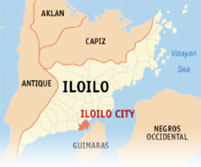 The Name. The natives, led by Datu Paiburong, named the place “Irong-Irong,” (most probably the Kiniray-a term for “Ilong-Ilong”) as its two main intersecting
rivers outline a nose. The colonizing Spaniards shortened the name to “Iloilo.”
The Name. The natives, led by Datu Paiburong, named the place “Irong-Irong,” (most probably the Kiniray-a term for “Ilong-Ilong”) as its two main intersecting
rivers outline a nose. The colonizing Spaniards shortened the name to “Iloilo.”
Iloilo, twice a city. Mainly due to its sugar-spurred economic growth, Spain promoted Iloilo to a city and the capital of Iloilo, the Province. The Commonwealth government, under the US of A, incorporated what was the Spanish La muy leal y noble ciuded de Iloilo into Iloilo City.
The Peoples. The Chinese, who antedated the Españoles, and other Asians, suchIndians, Iranians, Japanese, and, of late, Koreans, live in harmony and do lucrative business with Americans, British, Germans, and other westerners. All live harmoniously with the more than 400,000 day city residents.
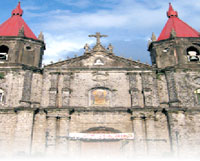 IC, the Capital. Located at the center of the Philippines, Iloilo City is the gateway to
the rest of Panay (Antique, Capiz, and Aklan) and nearby Guimaras, and Negros
Occidental. It is also regarded as the educational and government capital of the
region.
IC, the Capital. Located at the center of the Philippines, Iloilo City is the gateway to
the rest of Panay (Antique, Capiz, and Aklan) and nearby Guimaras, and Negros
Occidental. It is also regarded as the educational and government capital of the
region.
GETTING THERE...
By Air
By plane, it takes 55 minutes from Manila, about 25 minutes from
Cebu and 1 hour from Davao. The new airport of Iloilo is located
approximately 19 kilometers or 30 minutes from Iloilo City,
specifically in the town of Santa Barbara.
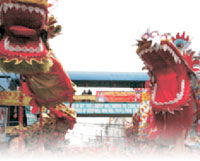 By Sea
By Sea
By boat, it takes 20 hours at most from Iloilo to Manila. From
Zamboanga 16 hours, Cagayan de Oro 14 hours, Cebu 12 hours. Bacolod City is a one-hour trip many times daily. Iloilo can also be
reached by Roll-on roll-off (RORO) vessels.
By Land
Iloilo is also accessible by land transportation to and from Aklan,
Capiz, and Antique.
Getting Around. When in a rush, hail a taxi; when at leisure, take
a jeepney; when adventurous, try a trisikad (pedicab).
Experience the…
Sights. Historic streets, forts, churches, stately mansions and Museo Iloilo are among the heritage sites of the city.
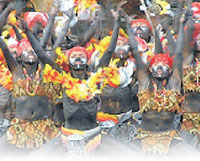 Events.
Events.
- Dinagyang - A colorful cavalcade in honor of the Holy Child Jesus amidst thundering drumbeats. This is Iloilo's version of the world famous “Ati-atihan Festival”. The rhythm of ancient music beats with the thundering cheers of rejoices and dances of merrymaking.
- Paraw Regatta - During this festival the dark gray sand beaches of Iloilo comes to life as spectators witness the annual race of colorful Paraws from Iloilo City to Guimaras Island. The Festival also coincides with the Rotaract Club of Iloilo City's annual Porma Balas Competition where people make sand sculptures along the shores of Villa Beach.
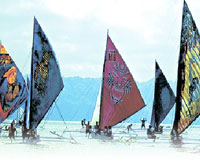 Feast of Our Lady of Candles - This annual religious festival (also known as Jaro Fiesta) is one of the biggest and most
flamboyant events in the Western Visayas. During the event, religious pilgrims bless candles as they join the procession of the
Nuestra Señora de Candelaria, which weaves its way through the streets of Jaro district every 2nd day of February. The fiesta
also features pageantry with a fiesta queen from one of the prominent families of the place, and a cockfight at the Iloilo
Coliseum, where cockfighting aficionados from all over the Philippines converge.
Feast of Our Lady of Candles - This annual religious festival (also known as Jaro Fiesta) is one of the biggest and most
flamboyant events in the Western Visayas. During the event, religious pilgrims bless candles as they join the procession of the
Nuestra Señora de Candelaria, which weaves its way through the streets of Jaro district every 2nd day of February. The fiesta
also features pageantry with a fiesta queen from one of the prominent families of the place, and a cockfight at the Iloilo
Coliseum, where cockfighting aficionados from all over the Philippines converge.- Chinese New Year - This festivities is a tribute to the very significant role that the Ilonggo Chinese community played in its history and development), highlighting the best of Chinese culture and tradition through songs, dances, stage plays, exhibits, fireworks displays and martial arts presentations.
Good Eats.
 Lapaz Batchoy is a combination of round noodles or miki, chicharon, pork innards, green onions, shrimp paste and chicken
eggs cooked in a rich meat broth.
Lapaz Batchoy is a combination of round noodles or miki, chicharon, pork innards, green onions, shrimp paste and chicken
eggs cooked in a rich meat broth.- Pancit Molo is a tasty wonton soup named after the well-known Ilonggo district.
- Seafood is a must. Feast on oysters and shellfish like Diwal (Angel Wing Shell) and Imbao, an array of fresh fish such as the popular Bulgan (Sea Bass) and Managat (Mangrove Jack), and an abundance of crabs, shrimps and prawns. Popular restos include Breakthrough, Tatoy's and Freska.
- Panderia de Molo biscuits like the famous galletas, ronquillos, and hojaldres still baked in traditional wood-fired ovens.
- Ilonggo Lechon Manok, native chicken roasted in tanglad (lemongrass) and other spices.
- Roberto's on JM Basa Street is known for their really huge siopaos, the Queen being the biggest is chockfull of bacon, chinese sausage, chicken pork adobo and egg all in one delicious bun.
- Sweet treats like butterscotch and biscocho are the all-time pasalubong favorites.
